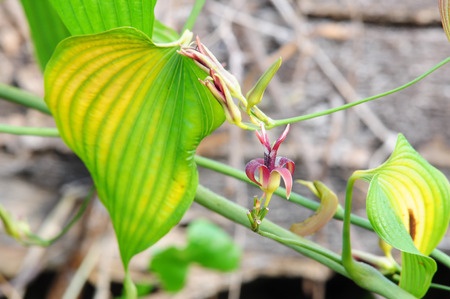Bai Bu - Japanese Stemona

Common Names: Bai Bu, Pai Pu, Stemona Root, Japanese Stemona, Radix Stemonae, Sheng Bai Bu, Stemona japonica
Latin Name: Stemona japonica (Stemona acuta)
Origin: Asia, Australia
Short Introduction
Bai Bu root is typically harvested in spring or autumn, with timing and quality assessment left to the experience of the gatherer. After harvesting, the fibrous roots are immediately separated, cleaned, and blanched in boiling water or steamed. The best quality root is robust, moist, firm, and white. To preserve the root for transport, it may be sun-dried, sliced, or processed with honey. While growing high-quality Japanese Stemona outdoors is generally not possible in most temperate climates, it may be feasible to attempt pot cultivation indoors at the end of winter or beginning of spring, followed by ample sunlight exposure during summer—for example, in a greenhouse to maintain moisture and warmth. Regular watering is crucial throughout the growing season. Even though success is not guaranteed, these methods might help the plant establish itself under less-than-ideal conditions, given patience, careful attention, and a favorable environment.
Detailed Description
Bai Bu, known as Japanese Stemona, is a traditional medicinal root most widely celebrated for its role in supporting respiratory health.
Botanical Information
Japanese Stemona (Stemona japonica) belongs to a group of perennial climbing herbs and low-growing shrubs first described around 1790. The plant features simple, heart-shaped, shiny leaves with pronounced vein patterns and smooth edges, which can vary in size depending on their native environment. Its flowers are elongated, pink to purple, and consist of several lengthy tepals and sepals. The primary part used for medicinal purposes is the thick, tuberous root, which is dense and can penetrate surprisingly deep into the soil.
Origin and Distribution
Japanese Stemona is indigenous to East and Southeast Asia, as well as the northern fringes of Australasia. Today, it is mainly cultivated in China, India, Taiwan, and neighboring countries, which are the largest producers and exporters of this therapeutic root. Traditionally, its cultivation and use have expanded throughout southern, eastern, and southeastern China, where it has been closely monitored and valued in medical practice.
Usage / Dosage
Bai Bu boasts notable and broad applications in herbal and respiratory medicine. In Traditional Chinese Medicine, it holds a distinguished place among the top 50 most used plants in clinical treatment. Bai Bu can be used alone or combined with other herbs. Its most valuable application is for moistening the lungs, bringing relief in cases of respiratory infections. It is especially recognized for its potency in soothing both acute and chronic cough from a variety of causes, including as a protective remedy against respiratory illnesses or bronchial disease of infectious origin. Remarkably, it also supports lung health in heavy smokers and alleviates annoying cough caused by loss of ciliated epithelial function. Studies have compared its muscle-relaxing properties for airway spasms to certain medications—yielding excellent results for bronchial spasm management. Its versatility makes it a reliable ally for various respiratory tract disorders.
Externally, Japanese Stemona proves highly beneficial for fungal or parasitic infections of the skin, especially in sensitive areas, as confirmed by a medical diagnosis. Decoctions prepared from the root can be used to wash or rinse affected areas. Components within the root also show significant effectiveness against lice infestations, making it useful for both prevention and as a supportive care agent after infection.
Scientific studies led by Chinese physicians observed the antibacterial properties of Bai Bu root extract, particularly in inhibiting the growth of Neisseria meningitidis and Escherichia coli, with alcoholic root extracts demonstrating pronounced activity. Isolated stilbenoid derivatives have shown moderate antibacterial action. Preclinical tests also found that ethanol maceration of the root inhibited Influenza A viruses, confirming its traditional antiviral use.
Further research has explored the potential for the root's compounds to slow the progression of specific thyroid cancers, where it appears to stop cancerous growth and encourage cellular apoptosis (regulated cell death). Another research team reported protective effects on the structure and connections of nerve cells in the central nervous system. Stemona has even been tested in cases of degenerative diseases such as Parkinson’s, where positive results support the need for further research and attention.
Active Compounds
The most important constituents are stilbenoids, alkaloid derivatives, and steroidal compounds. While these do not have steroidal anabolic effects, they exhibit antibiotic-like activity and influence the tension of smooth muscles in the respiratory system. Other constituents include free fatty acids, proteins, and organic acids.
Traditional Dosage
For internal use: simmer one tablespoon (about 10 g) of dried Bai Bu root in cold water for 30 minutes. This infusion can be sipped freely throughout the day. The decoction may be combined with medicinal wine or the dried root can be ground into powder for further use—often mixed with honey to improve taste.
For external use: boil 20–30 g of dried Bai Bu in cold water for 30 minutes, strain, and use this decoction to wash affected areas as needed.
